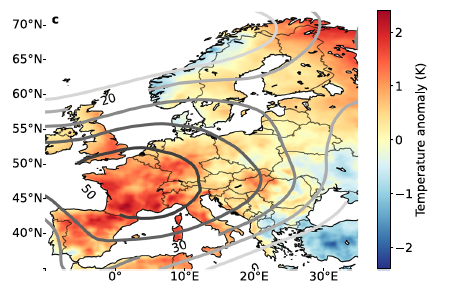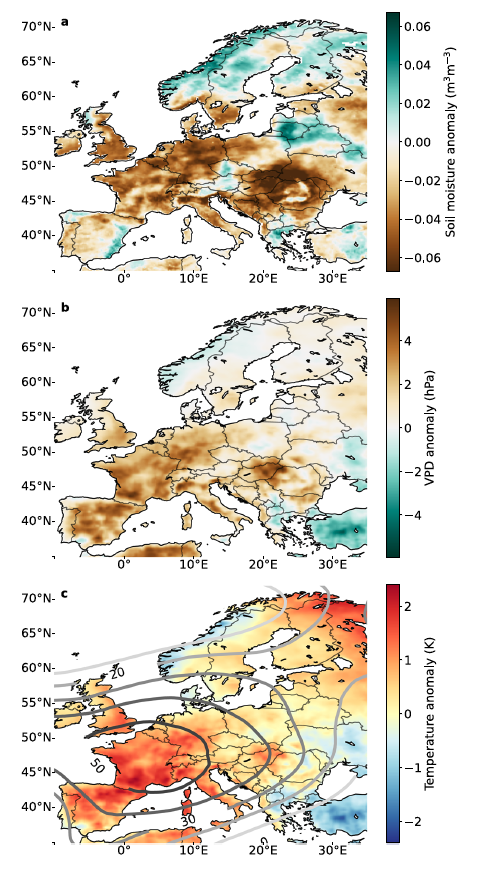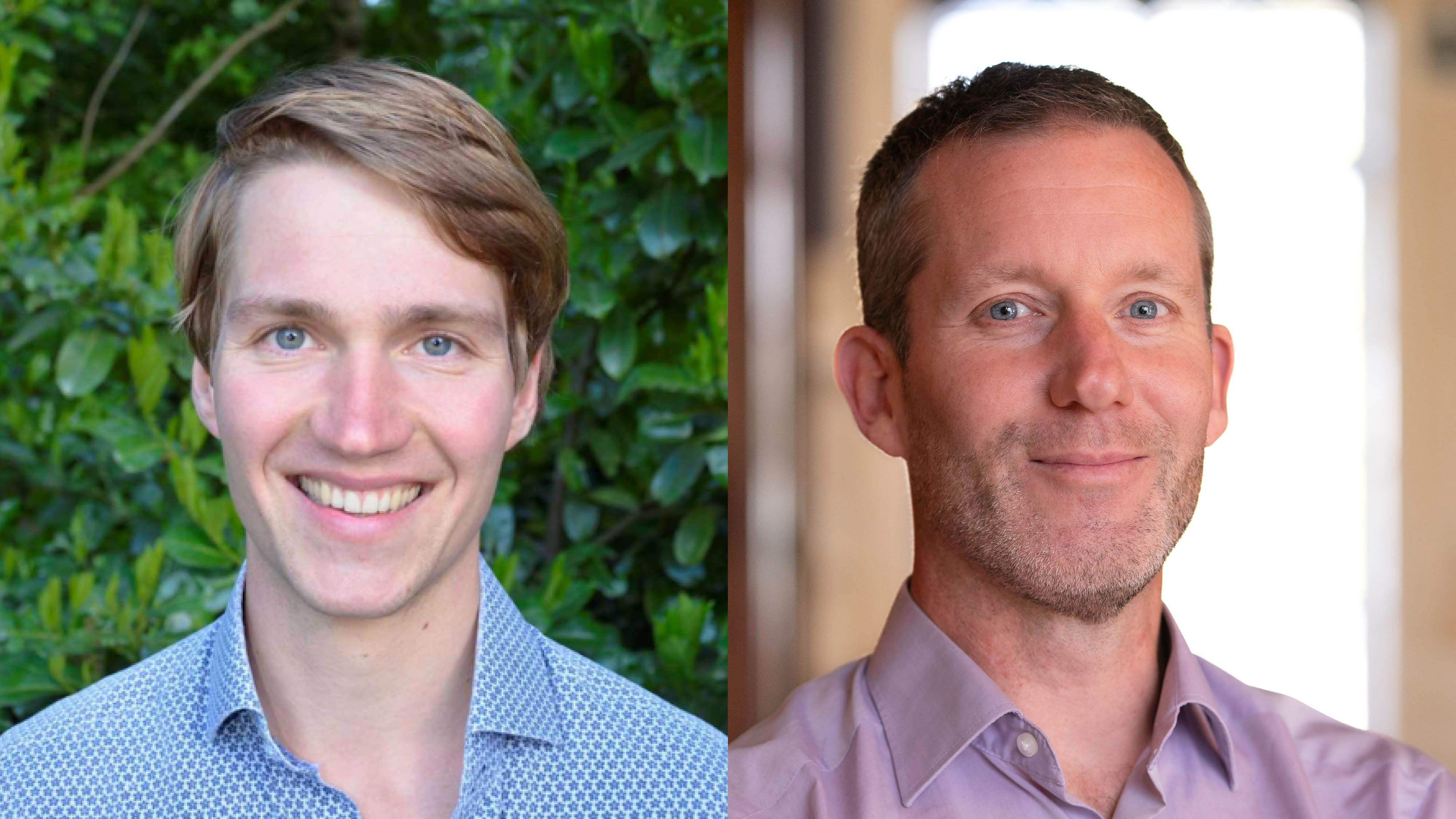
The year 2022 saw record-breaking temperatures in Europe during the summer and autumn. Close to 30% of the European continent was under severe summer drought. A study led by ICOS scientists shows that the extreme conditions lead to a reduced net biospheric carbon uptake in summer (56-62 TgC) over the drought area. This reduction of uptake was more than the yearly emissions of the country of the Netherlands and about 80% of the total yearly emissions of France.
A new ICOS study shows that extreme droughts reduce carbon uptake by European forests. The study “Temperature extremes of 2022 reduced carbon uptake by forests in Europe”, published in Nature Communications, brought together close to 100 scientists, technicians and coordinators from the ICOS community. The work was a continuation of the Drought 2018 study, which was done partly with the same people and using similar methods and analyses.
“Every drought shows us something new. We wanted to understand and quantify what happens in the biosphere following a drought, and apply newly created models that estimate the carbon dioxide fluxes in near-real time”, says lead author, PhD student Auke van der Woude.

The scientists compared the drought of 2022 to previous extreme droughts that took place in 2018 and 2003. By placing the 2022 drought in the context of previous strong summer droughts, the scientists wanted to answer the question of whether the impact of the drought on the carbon cycle was exceptional or exemplary of the droughts to come.
Extreme drought can stop photosynthesis completely
In contrast to the 2018 drought, which was preceded by a wet winter and a warm and sunny spring, the 2022 drought developed from already low soil moisture levels since the winter. Another relevant driver was the combination of atmospheric excess heat and low humidity. Drought itself is not unusual or dangerous, but a long-lasting, persistent drought becomes harmful.
“In the beginning, the forests take up carbon as long as conditions are good, but at some point, they cannot deliver anymore. The carbon uptake reduces, and in extreme cases, trees shut down their photosynthesis completely”, explains lead co-author Dr Wouter Peters.
Photosynthesis is the main way plants take up carbon from the atmosphere. The total shutdown of photosynthesis in the middle of the day to preserve water, measured at two sites in France, was the biggest surprise for Peters, personally. This was so out of the ordinary that the scientists interpreting the data first thought it was measured in the middle of the night.
“The trees would rather deprive themselves of carbon dioxide than give up even more water. It’s almost like they have to choose between three evils: losing all their water, dying of heat or dying of carbon starvation”, he says. “Such extreme behaviour is hardly in the textbooks we teach our students.”

The collaboration of ICOS scientists and new tools aided the study forward
Compared to 2018, the researchers had more advanced models in use and much better access to near-real-time data in 2022.
“We had just built this CarbonTracker Europe tool which shows carbon fluxes in Europe at high-resolution just two weeks behind real-time. We were waiting for a big event in the European carbon cycle to use it with”, van der Woude says. “We started building this system after the drought in 2018, because it showed us that there were a lot of questions we couldn’t answer quickly at that time. Now CarbonTracker is like an early diagnosis tool. If we are fast, we can do a study on drought right after the summer, as early as September or October.”
The ICOS community was involved from an early stage, and the research team formed quite naturally.
“We quickly had a team of modellers but knew we needed some measurements to contribute. We started with the eddy covariance observations, so Emilie Joetzjer joined the team. For atmospheric measurements, Michel Ramonet got involved, and Philippe Ciais and his team analysed the fires in France. Slowly a huge team began to form”, Auke van der Woude says of the team consisting of close to 20 authors.
“The ICOS Science Conference 2022 was very important”, van der Woude adds. “When we got together in Utrecht in September that year, we already started to put the team and the storylines together. We saw the expertise from various presenters aligned really well, and by October 2022 our project team was starting to write the actual paper.“

Wouter Peters also attributes some of the success of the collaboration to the maturity of ICOS RI and the capacity building that has taken place over the years. The ICOS Thematic Centres are now very optimised and can process data and take care of the necessary data quality protocols almost “on the fly”, he describes.
“And then there are a lot of PhD students like Auke here, who develop tools like CarbonTracker. Similarly, Emilie Joetzjer, who is an upcoming scientist and Principal Investigator of the Hesse Ecosystem station in France, was right on top of the eddy covariance data. There is just an amazing community behind all this data, and we really are grateful to everyone involved in ICOS.”
Extreme droughts are no longer exceptional
The study also points out the vulnerability of Eastern European forests, which are less adapted to dry conditions than Southern forests. Eastern Europe, moreover, is unfortunately not well monitored. This is supported by a recent analysis by Storm et al, which found that broadleaf forests and grass- and shrublands in South-Eastern Europe have high “monitoring potential” that has not yet been realized.

Van der Woude and colleagues write that in a 2-degree warmer climate, droughts are projected to occur once every 10 years in Europe, instead of once per 100 years in pre-industrial climate. Although every 10 years might not sound that dramatic, the scientists point out that such frequent droughts can quickly become dangerous to forests over time.
“The effects might linger on for 2-4 years when the forest reduces its carbon uptake in the following years”, van der Woude says. “And of course, if the forests die, it takes a while for them to regrow again and take up carbon.”
“We have to remember that forests operate on long time scales. Many of the trees we see now were there when the first T-Fords were manufactured”, Peters compares. “A drought like in 2022 would typically occur once in their lifetime, and now they’ve seen three in two decades, and there are more to come.”
The scientists emphasise that the severity of this second drought event in 5 years suggests that reduced carbon uptake caused by droughts can no longer be seen as exceptional. This is important to factor into Europe’s plans for net zero greenhouse gas emissions.
“We see droughts this magnitude happening in 2018 and now in 2022, and people still expect forests to increase their carbon uptake for climate change mitigation. This research shows that with more frequent droughts, we should not count on forests too much to reach our climate targets”, Peters concludes.
Auke M. van der Woude, Wouter Peters, Emilie Joetzjer, Sébastien Lafont, Gerbrand Koren, Philippe Ciais, Michel Ramonet, Yidi Xu, Ana Bastos, Santiago Botía, Stephen Sitch, Remco de Kok, Tobias Kneuer, Dagmar Kubistin, Adrien Jacotot, Benjamin Loubet, Pedro-Henrique Herig-Coimbra, Denis Loustau & Ingrid T. Luijkx: "Temperature extremes of 2022 reduced carbon uptake by forests in Europe." nature communications 14, no. 1 (2023): 6218. Read the full article here.